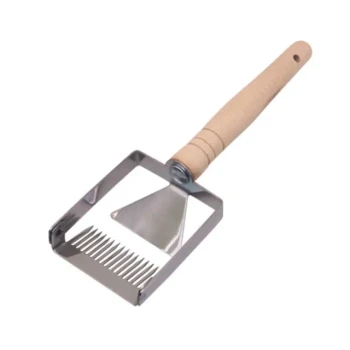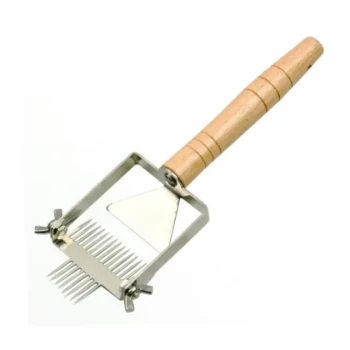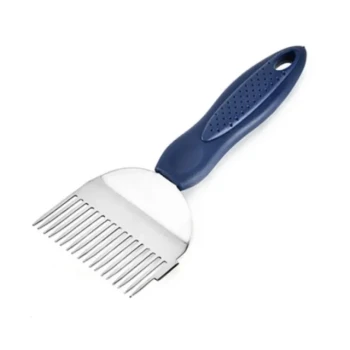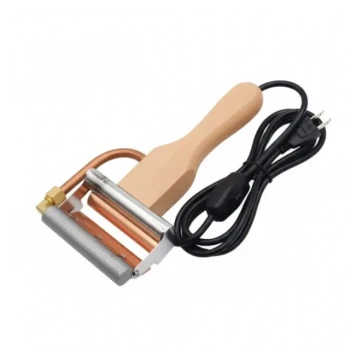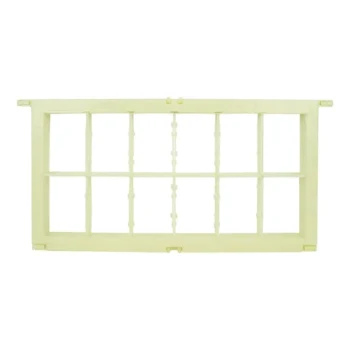In short, uncapping is a systematic process that involves using a specialized tool to slice off the thin wax layer that bees use to seal their honey-filled cells. The core steps include heating your uncapping knife, securing the honeycomb frame, slicing the wax caps from top to bottom, using a scratcher for any missed areas, and then placing the frame into an extractor for honey collection.
The goal of uncapping is not merely to remove the wax seals, but to do so cleanly and efficiently. A well-executed uncapping process maximizes honey yield while preserving the delicate honeycomb structure, saving the bees significant energy on their next cycle.

Preparing for a Clean Harvest: Tools and Setup
Before you make the first cut, having the right tools and a designated workspace is critical for an efficient and mess-free harvest. This preparation prevents frustration and protects the quality of your honey.
The Essential Toolkit
Your primary tool is what removes the cappings. An uncapping knife, which can be electric (self-heating) or a "cold" serrated knife (often warmed in hot water), is most common.
For recessed areas the knife can't reach, an uncapping scratcher or fork is indispensable. Its tines pierce the cappings in low spots on the comb.
Your Workspace
You will need a dedicated container or bin to hold the frames securely as you work. This is often called an uncapping tank.
You also need a separate, clean, food-grade container to collect the wax cappings, as they will be dripping with honey that can be reclaimed later.
The Uncapping Process, Step-by-Step
With your station prepared, the mechanical process of uncapping is straightforward and methodical. Work calmly and deliberately to ensure clean cuts and preserve the comb.
Step 1: Secure the Frame
Place the end of the honeycomb frame on a stable pivot point within your uncapping tank. Hold the frame securely with your non-dominant hand, tilting it slightly forward so the cappings fall away from the comb and into your collection bin.
Step 2: Heat Your Knife (If Applicable)
If you are using an electric uncapping knife, ensure it has reached its operating temperature. If using a "cold" knife, dip it into a tall pot of hot water to warm the blade, which helps it slice through the wax with ease.
Step 3: Execute the Cut
Begin your cut at the top of the frame. Rest the knife blade on the wooden frame edges as a guide and use a gentle, sawing motion to slice downwards. The goal is to remove only the wax cappings, taking as little of the underlying honeycomb as possible.
Step 4: Inspect and Detail with a Scratcher
After the main pass with the knife, inspect the frame for any sealed honey cells that were missed, particularly in low-lying or uneven areas of the comb. Use your uncapping scratcher to pierce these remaining cappings.
Step 5: Place in the Extractor
Once a frame is fully uncapped on both sides, place it immediately into your honey extractor. This minimizes drips and keeps your workspace organized as you move to the next frame.
Understanding the Trade-offs: Choosing Your Tool
While the steps are consistent, the tool you choose impacts speed, cost, and technique. There is no single "best" tool; the right one depends on the scale of your operation and your personal preference.
Electric Uncapping Knife
This is the tool for speed and efficiency. The heated blade melts through wax with minimal effort, making it ideal for beekeepers with many hives. The primary trade-off is the risk of slightly overheating or scorching the honey if you move too slowly.
Cold Knife or Serrated Bread Knife
A simple, non-electric serrated knife offers greater control and eliminates any risk of heating the honey. It is slower and requires more physical effort, as you must use a more deliberate sawing motion. Many beekeepers keep a pot of hot water nearby to warm the blade between frames.
Uncapping Scratcher or Fork
A scratcher is not ideal as a primary uncapping tool for a full frame, as it can be slow and damage the comb structure more than a knife. However, it is an essential secondary tool for cleanly opening cells in valleys and depressions that a knife blade will always miss.
Making the Right Choice for Your Goal
Your harvesting goals will dictate the best approach and toolset.
- If your primary focus is speed and efficiency for a large harvest: An electric uncapping knife is the clear choice to process many frames quickly.
- If your primary focus is precision and control with a small number of hives: A cold serrated knife, combined with a scratcher for detail work, offers excellent results without the added cost.
- If you are working on a minimal budget: A long, serrated bread knife warmed in hot water and a simple uncapping fork are perfectly adequate to get the job done effectively.
Ultimately, successful uncapping is a skill refined through practice, leading to a rewarding and pure honey harvest.
Summary Table:
| Step | Key Action | Essential Tool(s) |
|---|---|---|
| 1 | Secure the Frame | Uncapping Tank |
| 2 | Heat the Knife | Electric/Cold Knife, Hot Water |
| 3 | Execute the Cut | Uncapping Knife |
| 4 | Inspect & Detail | Uncapping Scratcher/Fork |
| 5 | Place in Extractor | Honey Extractor |
Ready to Optimize Your Harvest?
Whether you're a commercial apiary managing hundreds of hives or a distributor supplying the industry, the right equipment is the foundation of an efficient and profitable uncapping process. HONESTBEE supplies durable, high-performance beekeeping supplies and equipment through our wholesale-focused operations.
Let us equip you for success. Contact HONESTBEE today to discuss your specific needs and discover how our products can help you maximize honey yield and streamline your harvest.
Visual Guide

Related Products
- Automatic Honey Frame Uncapper Machine for Beekeeping
- Professional Wide Blade Honey Scraper for Beekeeping and Honey Processing
- Extra Wide Stainless Steel Honey Uncapping Fork with Scraper Beekeeping Tool
- Professional Stainless Steel Uncapping Fork with Wooden Handle
- Lightweight Plastic Uncapping Roller with Tines
People Also Ask
- Can both manual and electric extractors handle plastic or wax frames? Unlock Efficient Honey Harvesting
- What should be done with honey combs that are not fully capped? Trust the Bees for a Perfect Harvest
- Can honey extractors accommodate different frame sizes? A Guide to Choosing the Right Extractor
- How to uncap and extract honey? A Beekeeper's Guide to a Clean, Efficient Harvest
- Why might automation be necessary for uncapping honey frames in larger beekeeping operations? Scale Your Apiary Efficiently



